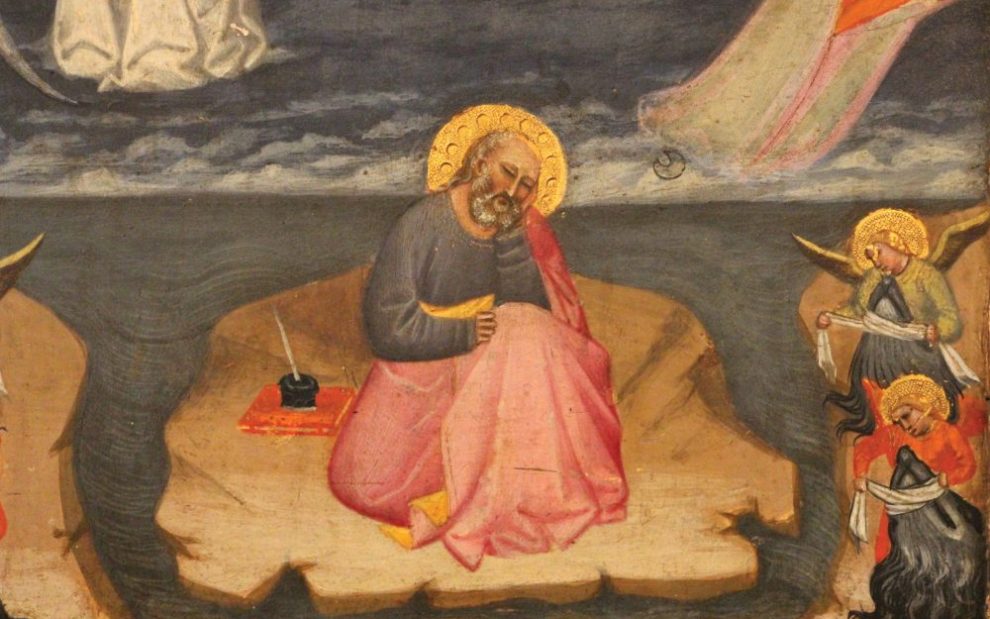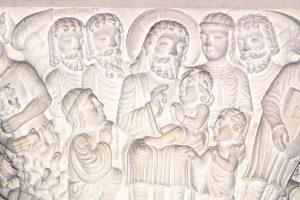Liars! Deceivers! Truth twisters! Alternative-fact-mongers!
This may sound like a litany snatched from recent headlines. Actually, it’s a basic theme in the New Testament letters of John. A closer look at the Bible often reveals that, despite the modern ring to an idea, “there’s nothing new under the sun”—including this quote, which comes from Ecclesiastes.
Since the first letter of John accompanies us through all the Sundays of Easter this year, it’s a good time to explore his message more closely. Why is John so concerned about separating liars from the trustworthy? A prior question we might ask is, who the heck is John? I know: Some of you could spend all day trying to work up a care about biblical authorship and come up empty. But if John is so concerned about whose witness we trust, it’s only right to inquire about his credentials.
Traditionally, several compositions from the early church were attributed to John, including a gospel, three letters, and the Book of Revelation. Yet only one of these manuscripts bears his name.
The assumption has generally been that the likely writer of documents arising from the Johannine tradition is the most impressive John in the gospels: the brother of James, son of the fisherman Zebedee, and one of three intimate disciples of Jesus along with James and Peter. The only apparent reason to believe that John wrote all these compositions is that he’s the John we know best. If we’re going to attribute authority to a sacred text, we’d like to source it to a friend and not a stranger.
Here are the facts: The Gospel of John never mentions the name John. It’s the only gospel that mentions Zebedee’s sons without naming them. The beloved disciple, who appears only in this gospel and is likewise assumed to be John, isn’t identified. Truth is, there are no Johns at all in the Gospel of John.
The three letters attributed to John, unlike Paul’s letters, bear no signature. The writer of the second and third letters calls himself simply the “Presbyter” or “Elder.”
The Book of Revelation does have an author: John of Patmos. Note the curious choice this John makes, defining himself not by paternity—the biblical standard—but by place. The apostle John we meet in Mark, Matthew, and Luke is always described as brother to James or son of Zebedee. Also, the apostle John is from the Galilean town of Capernaum. Patmos is an island 1,200 miles away in the Aegean Sea. People do travel, of course; but did ancient people change their attributions along with their addresses? After all, Jesus remains the “Nazorean” no matter how far he wanders from Nazareth.
So why are these texts attributed to Zebedee’s son from Capernaum? A significant church community in Asia Minor gathered around the fourth gospel the way Jerusalem Christians studied the narrative traditions of Mark, Matthew, and Luke—the three synoptic (similar) gospels. This Johannine church of Ephesus was led by an elder/presbyter named John.
In the second century, Bishop Irenaeus seems to have confused or morphed together this John with Zebedee’s son. Eusebius also notes confusion about the Johns, acknowledging that two tombs in Ephesus claimed to be John’s resting place. Eusebius imagines one of those is where John of Patmos was buried.
Could John the Elder of Ephesus have been Zebedee’s son? It’s possible. But even if he was a teenager when he followed Jesus, Zebedee’s John would have been 80 when writing the gospel and nearly 100 when the letters are composed. Then too, Mark’s gospel suggests both of Zebedee’s sons were martyred. Would John have been martyred as a very old man? It’s possible. But Mark’s gospel was the earliest written, around 70 CE. If Mark knew John was martyred, this makes the conflation of Zebedee’s son and John the Elder even less likely.
Ditto for a conflation of John of Patmos with Zebedee’s son. Once again, Irenaeus, one of our earliest sources, born around the year 130, and others attest that Revelation was composed late in Emperor Domitian’s reign, around 95 CE. That dates it to the same period as John’s gospel and makes it dubious Zebedee’s son was around to produce it.
Yet another reason John of Patmos is unlikely to be John from Capernaum is that he doesn’t call himself an apostle. This was an authority even those who didn’t follow Jesus during his ministry were eager to claim. If John claimed Patmos over apostleship, it would be an inexplicable choice.
Bottom line is, as much as we might like to attribute all these texts neatly to a single John and imagine him as John the apostle, there’s little evidence to support this. John the Elder of Ephesus and John of Patmos were both revered teachers of the early church. Their authority was good enough for their immediate communities and, through the three letters, to a larger swath of the church. This authority is also recognized by other heavy hitters: Irenaeus, Justin Martyr, Clement, Ignatius of Antioch, and the writer of the Didache.
But in this same generation, a crisis of authority ensues. The Johannine community centered in Ephesus fractures. The problem is the spin doctors, those teachers peddling alternative understandings about Jesus. They didn’t buy the incarnation, for instance: the concept that God would mix it up with our mortality.
This deletion, of course, turns the death of Jesus into mere theater: One who is not truly born can’t really die. The deceivers preferred divinity and humanity to remain in their own lanes. All of which was too much for some perplexed church members, who abandoned their faith in search of a less contentious religion or returned to their original, less complicated version of Judaism.
The writer of the letters of John, who may have been the Elder of Ephesus and/or possibly the author of John’s gospel, summons his authority to protest these departures. He pleads with the community to “remain” and “abide” with God in Christ. He reminds them Christ is the giver of life and complete joy. The Spirit enables us to “know” the truth—not a mental rational process but a form of spiritual illumination and discernment. The world is a chaotic and adversarial place, a realm of darkness inconsistent with the light of faith. It is, indeed, “antichrist” (in denial of Jesus as the Christ) and false. The truth belongs to those who cling to Jesus’ commandment to love and practice it as children of the light.
And John, whoever he was, is right. Being able to tell truth from lies is a vital task in every generation. Those who lack discernment of these two “spirits” are susceptible to ongoing deception and manipulation by the powers that be. Back in high school, my civics teacher told us to beware of advertising, media, and politics: three sources highly motivated to lie to us. It’s important we vet our sources carefully, discern who speaks with authority, and choose to abide with the truth—even if it costs us some cherished illusions. Jesus offers a way that is both truth and life for those who walk it. If an idea we hear bounced around doesn’t proceed from love and lead to more love, it’s antichrist for darn sure.
This article also appears in the April 2024 issue of U.S. Catholic (Vol. 89, No. 4, pages 47-49). Click here to subscribe to the magazine.
Image: Giovanni del Biondo, Rinuccini Chapel. Wikimedia Commons














Add comment